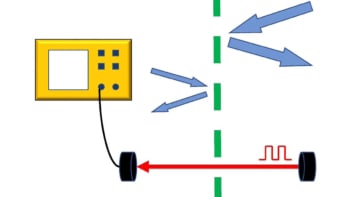
A prototype artificial neural network (ANN) that uses only light to function has been unveiled by researchers at the University of Münster in Germany and the University of Exeter and University of Oxford in the UK. Their system can learn how to recognize simple patterns and its all-optical design could someday be exploited to create ANNs that can process large amounts of information rapidly while consuming relatively small amounts of energy.
ANNs mimic the human brain by using artificial neurons and synapses. A neuron receives one or more input signals and then uses this information to decide whether to output its own signal to the network. Synapses are the connections between neurons and can be “weighted” to favour signal propagation between certain neurons. An ANN can be trained to perform a task such as recognizing a pattern by sending multiple examples of the target pattern through the ANN while tweaking the synaptic weights until all examples of the target pattern elicit the same output from the ANN.
Difficult architecture
Relatively simple ANNs can be implemented on a computer. However, the conventional computer architecture of having a separate processor and memory makes it very difficult to implement the large numbers of neurons and synapses required to perform practical tasks.
One alternative is to create an ANN in which signals flows in the form of light pulses through an optical network. This is attractive because unlike electronic signals in a silicon chip, large amounts of light-encoded data can move quickly through optical materials without generating much heat. Furthermore, large amounts of information can be sent through an optical system by multiplexing the data using several different colours of light.
There is, however, one big downside to the optical approach: light signals do not normally interact with each other – and interactions are required in the operation of both neurons and synapses. One way of getting around this is to convert optical signals to electrical signals – which interact easily — before converting the signals back to light for further transmission. This not an attractive solution because constant conversion and reconversion greatly increases the complexity and energy consumption of the network, while slowing the flow of information.
Phase-change material
In this latest all-optical neural network, the light-interaction problem is solved by using a “phase-change material” to create both the neurons and the synapses. This material switches between crystalline and amorphous phases when heated by a laser pulse. The amorphous phase is highly transparent, whereas the crystalline phase is nearly opaque.

Deep learning improves optical storage
“Because the material reacts so strongly, and changes its [optical] properties dramatically, it is highly suitable for imitating synapses and the transfer of impulses between two neurons,” says Johannes Feldmann who is part of the Münster team.
Using a phase-change material, the team built an all-optical chip comprising four artificial neurons and 60 synapses. The team tested their chip by using two established ANN learning algorithms – supervised and unsupervised learning – to train their network to recognize images made from black-and-white pixels in a 3×5 grid.
The team is now working towards creating much larger optical networks by implementing the technology on silicon optical chips using a commercial process.
The research is described in Nature.


